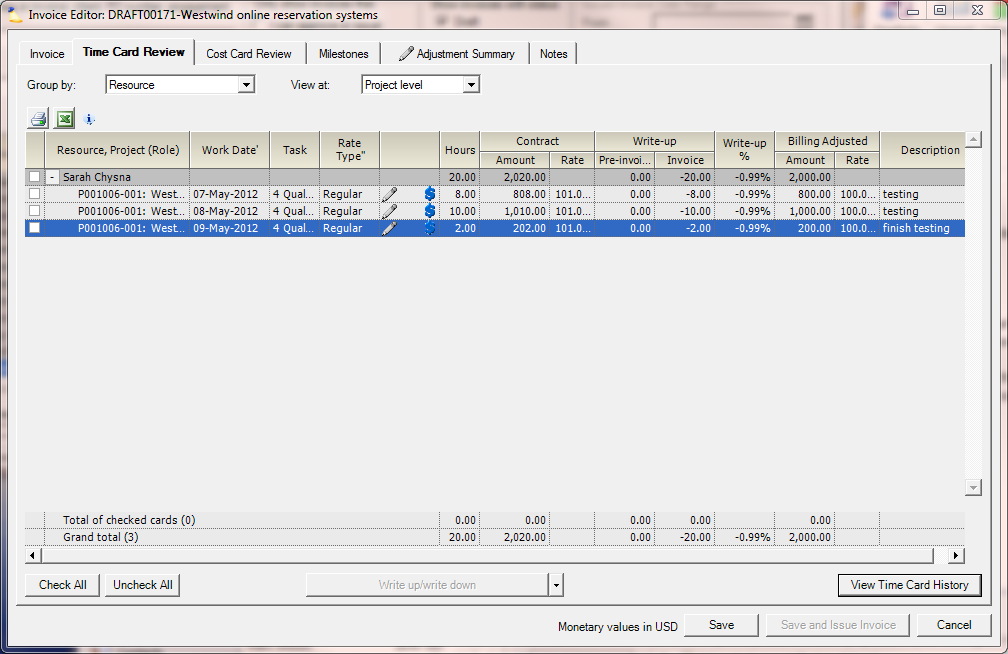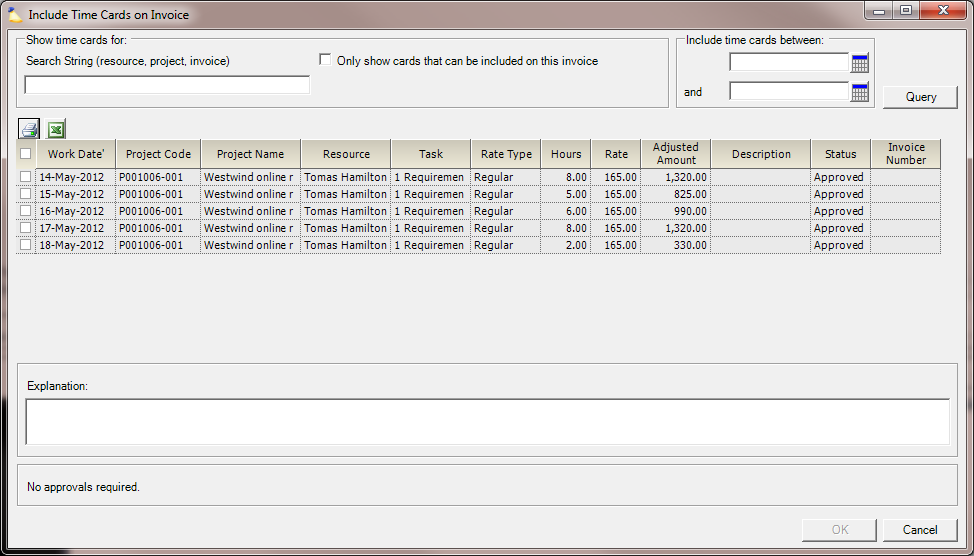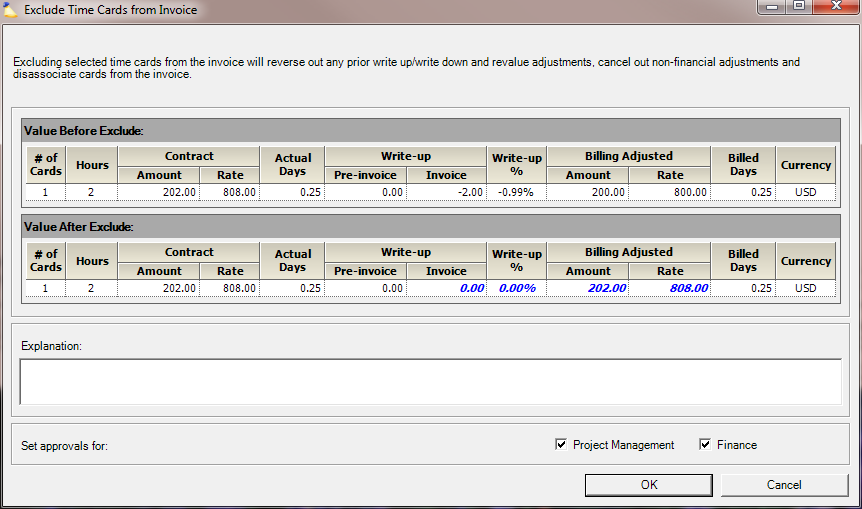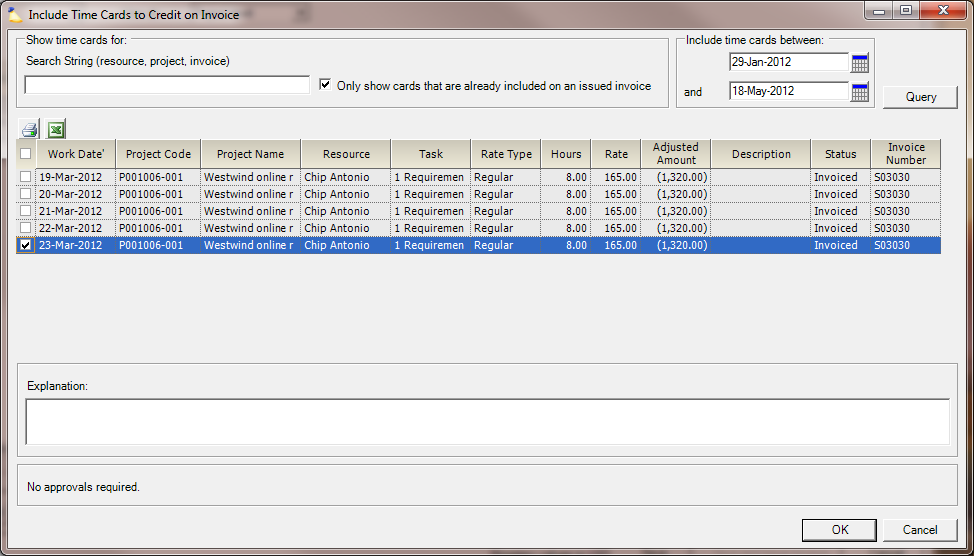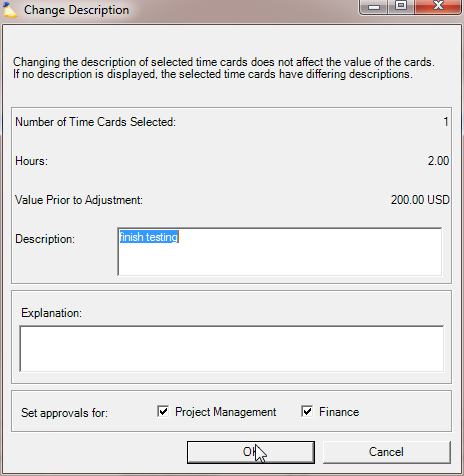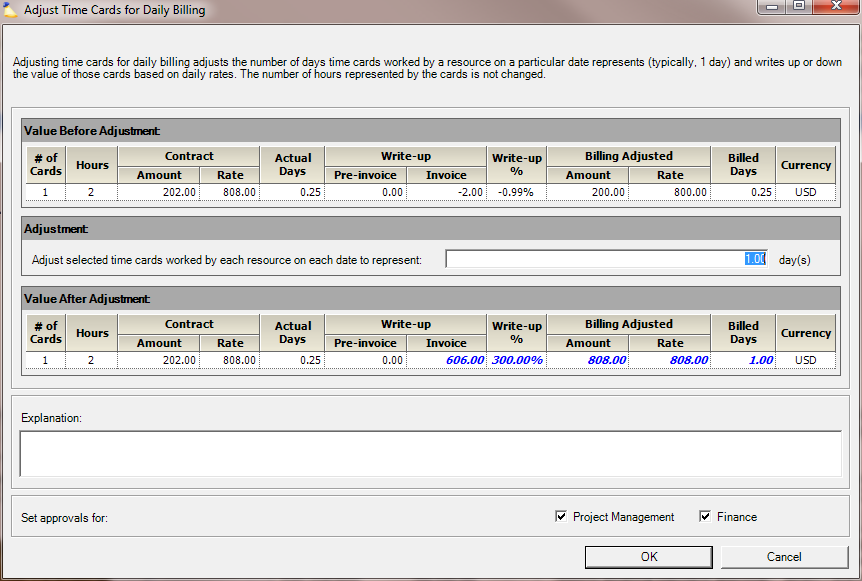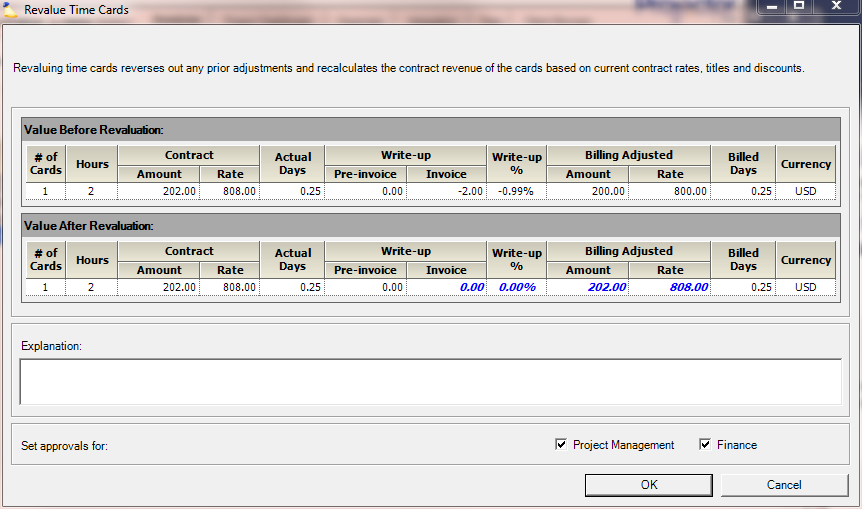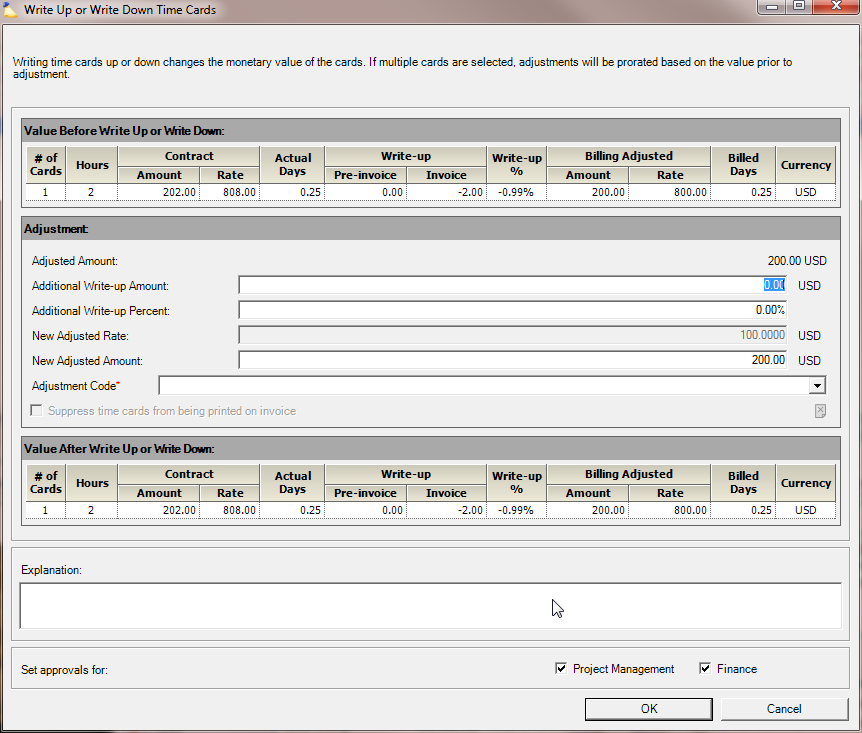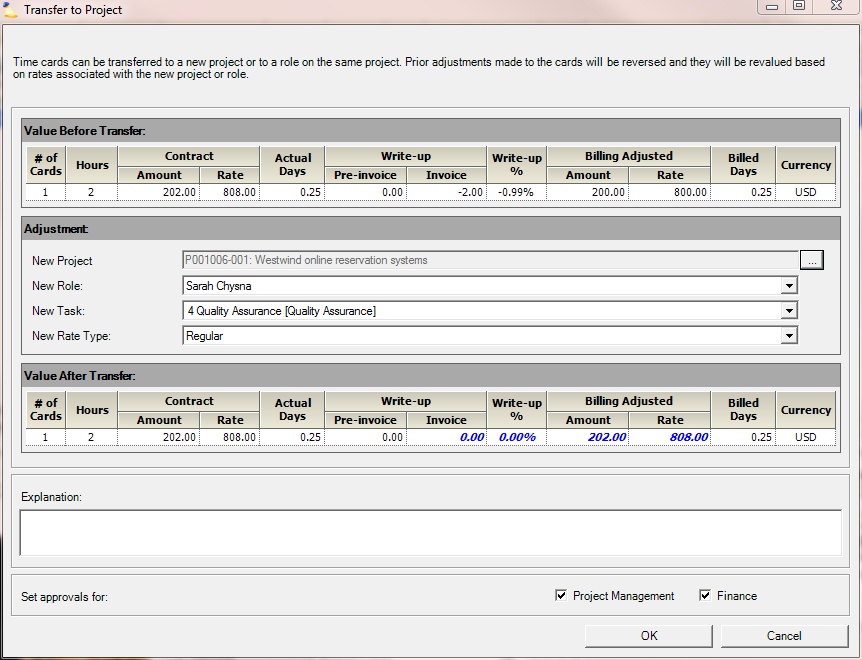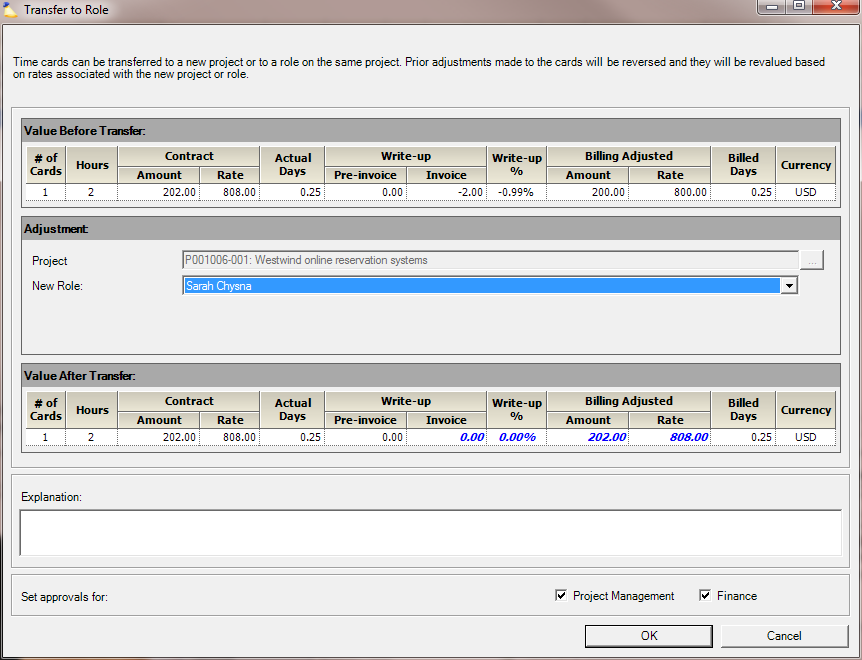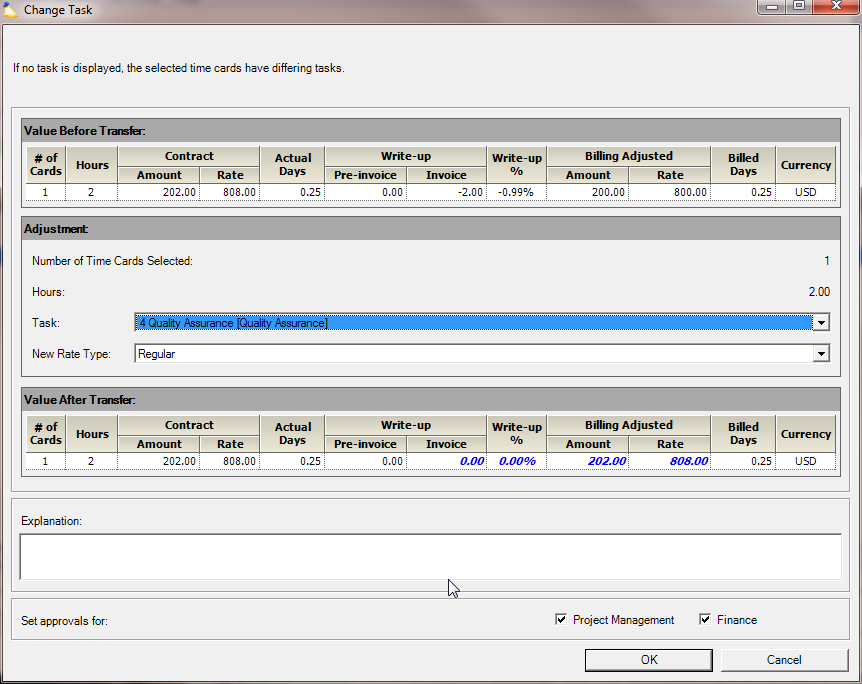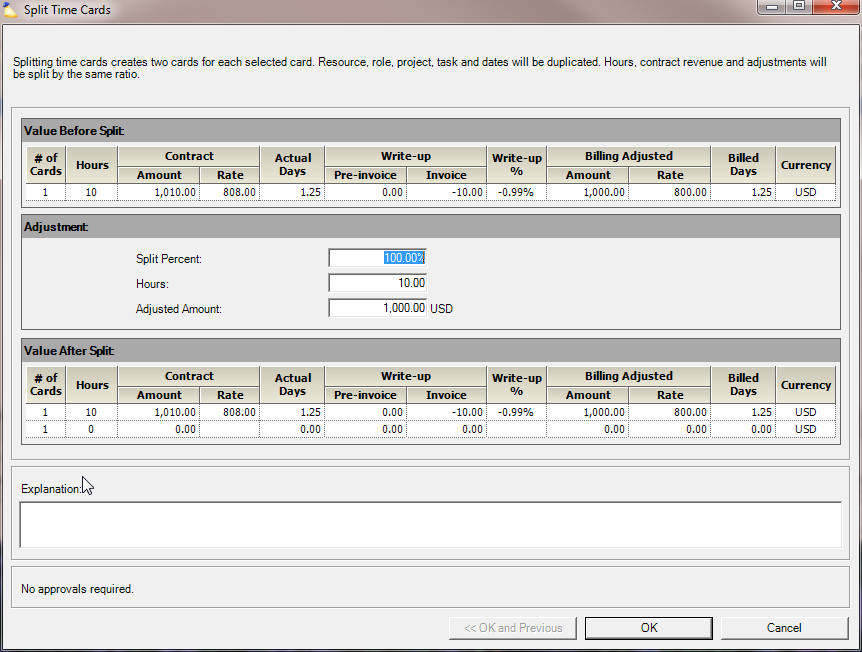Invoice Editor MP - Time Card Review Tab
The Time Card Review tab lists all the time cards currently included on the invoice. It displays the net effect of all adjustments, access to the history of time cards, and provides powerful tools to revalue, adjust, transfer, add, exclude and split time cards.
The Topic of the Day: Invoicing webinar is a great resource to learn all about creating invoices on Projector Management Portal.
This form is reached by opening an Invoice from the invoice tab, and selecting the Time Card Review tab.
From here you can easily see the amount of time each employee worked, what their working rate was and what the client is billed for. Values reflect all pending or approved adjustments, but not rejected adjustments.
You can make time card adjustments by checking the checkboxes next to each card and selecting an adjustment type from the menu at the bottom of the screen. See the sections below on each of the cost card adjustment types for more information.
Permissions and Settings
To perform adjustments such as write up/down, transfer, split, etc the accounting period must be open for adjustments.
The following people can make adjustments:
- Users with the cost center permission Create and Approve Invoices
- PMs for all projects on the invoice
Adjustments are queued and only executed once the invoice is issued. There is an exception to this rule, splits and project transfers occur as soon as the invoice is saved.
Display Options
Configure this form to display information in a manner that best suits your needs by using the following tools:
- Group by -- Time cards are grouped together by Project or Resource via collapsible buttons
- View at -- Expand or collapse the groups by making a selection from this list
Time Card Grid
Time card information is displayed in the columns of the grid.
Column | Description |
|---|---|
Checkbox Column | The first column contains checkboxes. Check time cards that you would like to modify. Modification details are discussed later on in this document. |
Project, Resource (Role) | The project to which the time was reported, the resource that reported the time, and the role that the resource played. Collapse or expand groups by pressing the plus ( + ) sign or minus ( - ) sign. |
Work Date | The day the work was done |
Task | The task that the resource performed on this project |
Rate Type | The rate type used to calculate the rate and amounts seen |
Hours | The number of hours reported |
Status Icons |
|
Contract | Contract revenue is what your negotiated rate was with the client. The contract amount may be modified by a revalue if the rates on the rate card, project, or role have been updated.
|
Actual Days | This column only shows up if billing by the day. The number of days worked given the specified number of hours per day on the rate card. If the number of hours in a day is 8, then 6 hours worked would yield .75 actual days worked. |
Write-up | The monetary value of adjustments made via Pre-invoicing Adjustments or Invoicing Adjustments discussed later on this page. |
Write-up % | = Total Write-up Amount / Contract Amount |
Billing Adjusted | Billing adjusted revenue is the amount that your client will be charged.
|
Billed Days | This column only shows up if billing by the day. The number of days billed given the specified number of hours per day on the rate card. If the number of hours in a day is 8, then billing for 10 hours worked would yield 1.25 billed days. This column only shows up when the invoice is being rendered for daily billing. |
Description | The information entered by the resource in the Description field of the time card. |
Totals for the time and financial columns are displayed in the following rows at the bottom:
Total of checked cards | Totals up all the checked time cards. The number of checked cards is shown in parentheses. |
Grand total | Totals up all time cards on the invoice. The number of cards on the invoice is shown in parentheses. |
Add Time Cards
From the multi-select drop down click Include time cards on invoice. The following dialog is shown where you can search for time cards to add. Only time cards that are submitted will be displayed. If a time card is not yet approved for invoicing then it shows up in results, but cannot be added to the invoice.
Parameter | Description |
|---|---|
Search string | Projector searches in the following fields
|
Only show cards that can be included on this invoice | Checking this box will find time cards ready for invoicing that meet the invoice parameters. Otherwise, submitted, but not approved time cards are shown. |
Date Range | Search within a specified date range. Leave either the start or end date blank to search from the beginning or end of time. |
Explanation | Enter a reason for the inclusion of the time cards. When viewing time card history this note will be viewable. |
Review the list of returned time cards and check the box beside each time card that you wish to include. Checking the box in the first row checks off all time cards.
Remove Time Cards
Check the checkbox next to cards that you wish to remove from the invoice. Then from the multi-select dropdown choose Exclude time cards from invoice. A confirmation dialog is shown detailing the effect on value due to exclusion. The time cards values may change due to an exclusion because of previous adjustments. Remember that invoice adjustments are not "real" until it is issued. So any write ups, transfers, etc will be undone.
Excludes differ slightly from other adjustments in that it is possible to execute exclusions without requiring approval from both the project manager and finance approver in certain cases. If you have the Create and Approve Invoices cost center permission then you can exclude time cards as long as there are no prior adjustments. This allows users who create invoices to be able to fine-tune the time cards or cost cards that are on an invoice prior to inserting it into the review and approval workflow.
If there are previous adjustments, or you do not have the cost center permission, then Project Management and Finance approvals will be necessary before the cards are officially excluded.
Credit Time Cards
Crediting a time card involves taking a previously invoiced time card and creating a credit for it on the current invoice. The client is charged the net amount of all charges and credits on the invoice. Like regular time cards, credits can be adjusted up or down as needed. So for example you could issue a credit for half of a charged time card.
You can only include time cards that are already on an issued invoice. If you see a time card, but cannot select it, then it is not on an issued invoice or is in a period closed for adjustments.
Parameter | Description |
|---|---|
Search string | Projector searches in the following fields
|
Only show cards that can be included on this invoice | When you search for time cards, we return everything that is currently approved. However, you can only issue credits for things are on a currently issued invoice. Tick this checkbox to cull out items that are not on an invoice or exist in time periods for which adjustments are closed. |
Date Range | Search within a specified date range. Leave either the start or end date blank to search from the beginning or end of time. |
Explanation | Enter a reason for the inclusion of the time cards. If the change requires approval by the project or finance manager they will see this message. When viewing card history this note will be viewable. |
Modify Card Descriptions
The change time card description adjustment is used to simply modify the descriptive text associated with one or more time cards. This adjustment has no financial impact on the time cards to which it is applied. You may want to change the description on a time card if the current one is inappropriate, not descriptive enough or many other reasons. If the description field is blank when you enter this dialog then either all selected time cards have no description or they have different descriptions. After the adjustment all selected time cards will have the same, new description.
Adjusting Time Cards
One of the most powerful features of Projector's invoicing is the ability to modify time cards on the invoice.
Adjustments are not "real" until the invoice is issued, so you know that as you experiment with which adjustments are best, you are not distorting the reports or dashboards for other users. For more see our FAQ - How come my invoice adjustments don't show up in my reports
The Adjustment Screen
All time card adjustment screens share a common layout. There is an upper section that shows the current value of the selected time cards. Then there is a middle section where you specify the changes you want made. Finally there is the lower section which details the effects of those changes. The following table describes the various fields you will encounter when adjusting time cards. At the bottom of the screen you can optionally set finance and project manager approval if you have sufficient permissions.
Projector supports the following adjustments:
- Revalue
- Write up/write down
- Adjust for daily billing
- Transfer to project
- Transfer to role
- Change task
- Change rate type
- Split
Column | Description |
|---|---|
Number of Time Cards Selected | The quantity of card(s) selected for modification |
Hours | The total hours across the selected time cards |
Contract Amount | The contract rate is your negotiated rate. The contract rate may be updated if your negotiated rates have changed since the project was created. |
Contract Rate | The contract amount divided by the hours on the time cards |
Pre-invoice | The monetary value of modifications made via Pre-invoicing Adjustments |
Invoice | The monetary value of modifications made via the Invoice Editor MP (where you are right now) |
Write-up % | The percentage of the modifications, which is computed by the total write-up amount divided by the contract amount. |
Billing Adjusted Amount | This is the amount that the client will get billed. It is the sum of the contract rate plus any adjustments. |
Billing Adjusted Rate | The billing adjusted amount divided by the hours |
Currency | The currency of the time cards |
Explanation | Explain why the change was made. This could be important if you execute an audit down the road and wish to recall why certain changes were made. |
Set Approvals For | Optionally set finance and project manager approval if you have sufficient permissions |
Revalue
When a time card is approved it is assigned a value. It is assumed at the time of approval that everything about that card is appropriately set. Projector calculates the value and assigns it to the card. How this value is calculated can be done a number of ways. For example the rate may be driven by who did the work, what was worked on or whether it was overtime work.
The Revalue time cards form allows you to recalculate this default value and reassign it to the time card. This adjustment is useful when rates have changed since the time cards were originally valued and you wish to use the newly edited rates. For example, say implementation work bills at $200 an hour, but you have decided to cut the client's rate to $180. Changing the rate does not change time cards that have already been approved. By executing a revalue, you are asking Projector to recalculate the values
This adjustment is also useful when you need to undo previous adjustments and set things back to the way they would be by default. Say you wrote up a dozen cards, but later realized this was not the correct decision. Instead of finding those cards and back calculating what they should have been, you can use a revalue to reset them.
Write Up/Down Time Cards
Write up or down time cards to change the amount that the client will be charged. Changing one field automatically recalculates the others. The adjustment amount will be prorated across all time cards being adjusted.
Adjustment | Description |
|---|---|
Adjusted Amount | The value before any adjustments. This field is read-only and cannot be changed. |
Additional Write-up Amount | Enter a specific amount to spread across the selected time cards. If you have two time cards and enter $100 then each card will get +$50. |
Additional Write-up Percent | Enter a specific percent to modify the time cards. Each time card's value will change by that percent. |
New Adjusted Rate | This field will be prepopulated only if all time cards have the same initial rate. Even if they do not, you may still enter a value in this field to set all time cards to the same rate. This field is not available if you have Daily Billing enabled to prevent users from adjusting the hourly rate by accident when they really meant to adjust the daily rate. |
New Adjusted Amount | Enter a specific amount that all time cards should sum to. The difference between this new amount and the old amount will be spread evenly across the time cards. For example, if you had four cards that added up to $200 and entered a new amount of $300 – the difference ($100) would be spread evenly across the four time cards. $25 a piece. |
Adjustment Code | Choose an adjustment code for this write up/down. Adjustment codes are used within Projector to explain why an invoice has been adjusted. |
Suppress time cards from being printed on invoice | You can optionally hide zero dollar time cards from being printed on an invoice. They are still part of the invoice, just none of the detail is shown on the printed version. This is useful when you have non-billable work that you don't want your client to see or if the client just doesn't care about it. If you have the system setting Automatically suppress display of zero-amount time cards on invoice ticked, then suppression happens automatically. You can always manually override the suppression status of time cards by editing this setting. |
Adjust for Daily Billing Form
Daily billing allows you to round hours to a whole day and invoice for that day. For example, if you worked four hours, but your minimum billing is for one full day. The bill will be adjusted up from four to eight hours. This adjustment is only available if you are billing by the day as specified on the invoice tab. You should choose an invoice template that is customized to show daily billing. To learn more about daily billing see Hourly vs. Daily Billing.
Make your daily billing adjustments after all other adjustments. Otherwise you'll overwrite your own changes. For example,
- Adjust for daily billing
- Change a time card's task (triggers revalue which undoes your daily billing adjustment)
- Redo daily billing
When selecting multiple time cards for the same resource on the same day, adjustments are made together (ignoring role, task and project). For example, Shelby entered three time cards on the same day against three separate tasks. The hours on the three cards are combined and adjusted to equal one eight hour day.
When selecting multiple time cards for different resources on the same day, adjustments are made for each resource. For example, if John works two hours and Jane work four hours, each is written up to eight hours. The time cards are not combined to equal six and then adjusted up to one eight hour day.
Adjusting for daily billing triggers a revalue which can affect both billing adjusted and contract revenue.
When adjusting for daily billing, the time card grid has two extra columns: Actual Days and Billed Days. This way you can see the difference between what was done vs. what was charged.
Adjust selected time cards worked on each day to represent – Choose the number of days that the entered time will represent. Typically this is just one, but can be any number up to two decimal places.
Transfer to Project Form
The transfer time cards to project adjustment is used to move one or more time cards from one project to another. This adjustment type is typically used when a resource has logged time to the wrong project.
When you select a new project, you will also need to select a new role, task and rate type. When selecting multiple cards to transfer, you can only transfer the cards to a new project if all the selected cards are associated with the same resource.
When time cards are transferred,
- any changes made on the invoice to the time cards are removed
- cards are transferred
- they are revalued using the new project's role, task and rate type
If a time card is transferred to a project that is not part of the current invoice, the adjustment will also exclude the card just prior to revaluing it. In addition, when the transfer involves this type of exclusion of a time card, the transfer and exclude is executed as soon as the invoice is saved with the transfer adjustment in a fully approved state. The time cards will then reflect the new project and will be eligible for inclusion on other invoices so that the billing process for other projects will not be held up. Once executed, the transfer cannot be undone.
If you attempt to transfer expenses where the card work date is outside of the project start and/or end date, you will be warned that the dates will be adjusted to accommodate the transfer. See Warning - Transferring these cards to this project will cause the open or close date to be adjusted
- New Project – The project to which this time is to be transferred. Press the ellipsis button to search for the target project.
- New Role – Open the drop-down menu and choose the new role to which the card(s) will be transferred.
- New Task – Open the drop-down menu and choose the new task.
- New Rate Type -- Open the drop-down menu and choose the new rate type.
Transfer to Role Form
The transfer time cards to role adjustment is used to move cards from one role to another on the same project. This adjustment is typically used because a resource that holds multiple roles on a project has entered some time against the incorrect role.
When this adjustment is applied, any prior write up and write down adjustments applied to the time cards being transferred are reversed and the time cards are revalued using contract rates on the new role.
Time cards can only be transferred into an existing role for the same resource or into a new role. Time cards cannot be transferred from one resource to another.
- Project – The project to which this time was reported.
- New Role – Open the drop-down menu and choose the new role to which the card(s) will be transferred. The choices will include roles that the same resource is requested for or booked to on this project.
Change Task Form
The change time card task adjustment is used to simply change the task associated with one or more time cards. This adjustment has no financial impact on the time cards to which it is applied.
- Task -- The new task for the card(s). Open the drop-down menu to choose another task or task code. Tasks codes for the new project are determined on the Tasks tab of the Project Editor for a project not using detailed task management. Tasks for projects using detailed task management are found on the Task Planning tab of the Project Editor.
- Rate Type -- Select the new rate type
Change Rate Type
Use Transfer to Project to change the rate type.
Split Time Cards
A split time card adjustment can be used to divide a time card into two separate cards. The number of hours and all financial values are proportionately spread across the cards. Any write up, write down and revalue adjustments that may have been applied to the time card prior to the split are likewise allocated across the two cards. As just splitting a time card isn't particularly interesting, it is often used in conjunction with another adjustment. For example, you might split a card and then transfer half to a different project. Or you might split a card and then exclude half from this invoice for billing at a later time.
Unlike other adjustment types, split card adjustments always apply to a single card. If you need to split multiple cards, you need to specify the split for each one. To facilitate this workflow, you can select multiple cards for splitting and then Projector lets you scroll back and forth among all the cards being split.
Split card adjustments do not require approval, and are executed as soon as you save the invoice.You cannot undo a split.
- Split Percent – The percentage of the time to be assigned to the existing card after the split
- Hours – The quantity of hours to remain on the existing card after the split
- Adjusted Amount – The remaining value of the existing card after the split
Viewing Time Card History
Projector enables you to view the history of a time card in greater detail. Double click a row to open the Time Card History Viewer.
Sorting Columns
Click on a column heading to sort the data by that column in alphabetical, chronological or numerical (as appropriate) order.
To sort on one column just click on that column's header.
To sort on two columns, click on the column header for the secondary sort first. Then click on the column for the primary sort. So to sort by name, then date: Click date column. Click name column.
